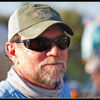I have been off the water for the last couple of weeks, so I don't have a local fishing report. However, tarpon fishing has been strong in Sarasota as schools of fish have increased in size and numbers during that time frame. Tarpon will head offshore to spawn on this weekend's new moon and will return to the beach within a few days as singles, doubles and smaller schools giving fly anglers good opportunities.
Use tackle heavy enough to land them as quickly as possible. When using conventional tackle, I use 7', 30 to 40-lb class spinning rods and Quantum Boca or Cabo 60 reels with 50-pound Power Pro braid. According to Florida law, tarpon longer than 40" must remain in the water. Dragging a tarpon up onto the gunnel of your boat could damage internal organs and result in their death. After landing a tarpon, they should be properly revived by pulling them slowly alongside your boat to move water through their gills until they are strong enough to swim away.
I travel well offshore of the beach at first light in the morning to avoid disturbing schools of tarpon that may be traveling or "laid up" close to the beach. Once I've reached the area I intend to fish, I'll ease into the beach with an electric trolling motor and set up in my spot, either anchoring or drifting, depending on conditions. Set up in travel lanes along the beach and cast live crabs, baitfish, DOA Baitbusters and Swimming Mullet to them. The new CAL 4" Shad Tail with an Owner Beast 6/0 weedless hook is a good tarpon lure, especially when sight fishing in shallow water. I often drift a couple of live baits under a float while waiting for tarpon schools to pass by.
When fly fishing, I use 12-weight rods and large arbor reels capable of holding at least 300-yards of backing and cast a variety of baitfish, shrimp or crab fly patterns fished on floating or intermediate sink tip fly lines. The shallower the water, the easier it is to get your fly in front of a fish when fly fishing. Stake out or anchor in travel lanes to get shots at them. Give other anglers at least 200-yards of space. Since fish may be moving both north and south, setting up too close to another angler may negatively affect their fishing.
Snook season is closed now on the west coast of Florida, but catch and release night snook fishing around lighted docks and bridges in the ICW or in the surf with flies and DOA Lures should also be good. Look for reds, snook and big trout mixed with mullet schools or cruising shallow flats and edges of bars in Sarasota Bay or backcountry areas of Charlotte Harbor and lower Tampa Bay. Trout, Spanish mackerel, bluefish and more should be good options on deep grass flats of Sarasota Bay.
Tight Lines,
Capt. Rick Grassett
IFFF Certified Fly Casting Instructor
Orvis-Endorsed Fly Fishing Guide at CB's Saltwater Outfitters
Orvis Outfitter of the Year-2011
Snook Fin-Addict Guide Service, Inc.
www.snookfin-addict.com, www.snookfinaddict.com and www.flyfishingflorida.us
E-mail snookfin@aol.com
(941) 923-7799

